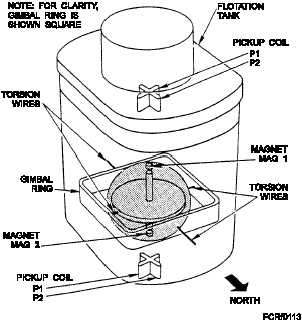stabilizing gyros used in today’s ships.
The
maintenance and operation of these gyros is the
responsibility of the Interior Communications (IC)
technicians. Figure 1-13 shows a phantom view of a
gyro you might see on your ship.
The primary purpose of the stable element for fire
control equipment is to measure accurately any
deviation of the reference element (antenna, director,
launcher, etc.) from the horizontal plane. Deviation
measurements are sent to the fire control computer to
create a stationary foundation from which to solve the
fire control problem. They are also sent to the gun
director, radar antenna, or optical equipment,
depending upon the fire control system, to stabilize
these units of the fire control system.
Q5. What is the switching time of a duplexer called?
Q6. What are the two types of lens antennas?
Q7. What determines the position of a phased array
antenna beam?
Q8. What part of a radar system provides computer
control for an equipment group?
Q9. What is the primary purpose of the stable
element for fire control equipment?
TYPES OF RADAR SYSTEMS
Because of different design parameters, no single
radar set can perform all the many radar functions
required for military use. The large number of radar
systems used by the military has forced the
development of a joint-services classification system
for accurate identification of radars. Radar systems are
usually classified according to their specific function
a n d i n s t a l l a t i o n v e h i c l e .
T h e j o i n t - s e r v i c e
standardized classification system divides these broad
categories for more precise identification.
Since no single radar system can fulfill all the
requirements of modern warfare, most modern
warships, aircraft, and shore installations have several
radar sets, each performing a specific function.
A
s h i p b o a r d
r a d a r
i n s t a l l a t i o n
m a y
i n c l u d e
surface-search and navigation radars, a 3D radar, an
air-search radar, and various fire-control radars.
Figure 1-14 is a listing of equipment identification
indicators.
You can use this table and the radar
nomenclature to identify the parameters of a particular
radar set. The example given explains the equipment
indicators for the AN/SPY-1A radar system.
The letters AN were originally adopted by the
Joint Army-Navy Nomenclature System, also known
as the AN system, to easily classify all military
electronic equipment.
In 1985, Military Standard
MIL-STD-196D changed the name of the Joint
Army-Navy Nomenclature System to the “Joint
Electronics Type Designation System (JETDS)”, but
the letters AN are still used in identifying military
electronics equipment.
AIR-SEARCH RADAR
The primary function of an air-search radar is to
maintain a 360-degree surveillance from the surface to
high altitudes and to detect and determine ranges and
bearings of aircraft targets over relatively large areas.
The following are some uses of an air-search radar:
Give early warning of approaching enemy
aircraft and missiles, by providing the direction
from which an attack could come. This allows
time to bring antiaircraft defenses to the proper
degree of readiness and to launch fighters if an
air attack is imminent.
Observe constantly the movement of enemy
aircraft.
When it detects an enemy aircraft,
guide combat air patrol (CAP) aircraft to a
position suitable for an intercept.
Provide security against attacks at night and
during times of poor visibility.
Provide information for aircraft control during
operations that require a specific geographic
1-12
Figure 1-13.—Phantom view of a gyro.


